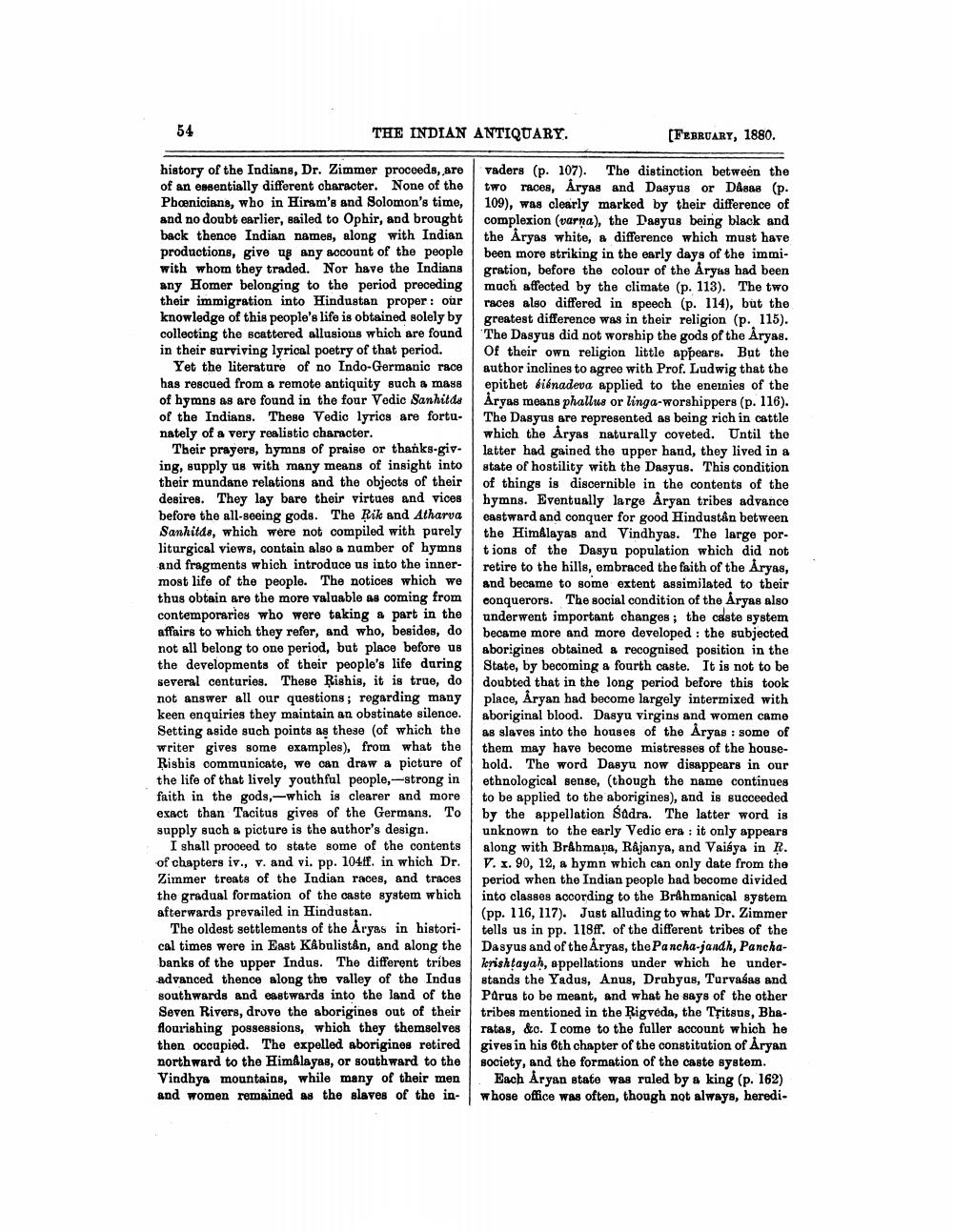________________
THE INDIAN ANTIQUARY.
[FEBRUARY, 1880.
history of the Indians, Dr. Zimmer proceeds, are vaders (p. 107). The distinction between the of an ensentially different character. None of the two races, Aryas and Daayus or Dasas (p. Phænicians, who in Hiram's and Solomon's time, 109), was clearly marked by their difference of and no doubt earlier, sailed to Ophir, and brought complexion (varna), the Dasyus being black and back thence Indian names, along with Indian the Aryas white, a difference which must have productions, give us any account of the people been more striking in the early days of the immiwith whom they traded. Nor have the Indians gration, before the colour of the Aryus had been any Homer belonging to the period preceding much affected by the climate (p. 113). The two their immigration into Hindustan proper : our races also differed in speech (p. 114), but the knowledge of this people's life is obtained solely by greatest difference was in their religion (p. 115). collecting the scattered allusions which are found "The Dasyus did not worship the gods of the Aryas. in their surviving lyrical poetry of that period. Of their own religion little appears. But the
Yet the literature of no Indo-Germanic race author inclines to agree with Prof. Ludwig that the has rescued from a remote antiquity such a mass epithet diénadeva applied to the enemies of the of hymns as are found in the four Vedic Sanhilds Aryas means phallus or linga-worshippers (p. 116). of the Indians. These Vedic lyrics are fortu- The Dasyus are represented as being rich in cattle nately of a very realistic character.
which the Aryas naturally coveted. Until the Their prayers, hymns of praise or thanks-giv.
latter had gained the upper hand, they lived in a ing, supply us with many means of insight into state of hostility with the Dasyus. This condition their mundane relations and the objects of their of things is discernible in the contents of the desires. They lay bare their virtues and vices hymns. Eventually large Aryan tribes advance before the all-soeing gods. The Rik and Atharva eastward and conquer for good Hindustan between Sanhitda, which were not compiled with purely the Himalayas and Vindhyas. The large porliturgical views, contain also a number of hymns tions of the Dasyu population which did not and fragments which introduce us into the inner- retire to the hills, embraced the faith of the Aryas, most life of the people. The notices which we
and became to some extent assimilated to their thus obtain are the more valuable as coming from conquerors. The social condition of the Aryas also contemporarios who were taking a part in the underwent important changes; the caste system affairs to which they refer, and who, besides, do became more and more developed : the subjected not all belong to one period, but place before us aborigines obtained a recognised position in the the developments of their people's life during State, by becoming a fourth caste. It is not to be several conturies. These Rishis, it is true, do doubted that in the long period before this took not answer all our questions regarding many place, Aryan had become largely intermixed with keen enquiries they maintain an obstinate silence. aboriginal blood. Dasyu virgins and women camo Setting aside such points as these (of which the as slaves into the houses of the Aryas : some of writer gives some examples), from what the them may have become mistreens of the hones Rishis communicate, we can draw a picture of hold. The word Dasyu now disappears in our the life of that lively youthful people,-strong in ethnological sense, (though the name continues faith in the gods, which is clearer and more to be applied to the aborigines), and is succeeded exact than Tacitus gives of the Germans. To by the appellation Stdra. The latter word is supply such a picture is the author's design. unknown to the early Vedic era : it only appears
I shall proceed to state some of the contents along with Brâhmana, Rajanya, and Vaibya in . of chapters iv., v. and vi. pp. 1041f, in which Dr. V. x. 90, 12, a hymn which can only date from the Zimmer treats of the Indian races, and traces period when the Indian people had become divided the gradual formation of the caste system which into classes according to the Brahmanical system afterwards prevailed in Hindustan.
(pp. 116, 117). Just alluding to what Dr. Zimmer The oldest settlements of the Aryas in histori- tells us in pp. 118ff. of the different tribes of the cal times were in East Kâbulistân, and along the Dasyus and of the Aryas, the Pancha-jandh, Panchabanks of the upper Indus. The different tribes kerishtayah, appellations under which he underadvanced thence along the valley of the Indus stands the Yadus, Anus, Drubya, Turvasas and southwards and eastwards into the land of the Paras to be meant, and what he says of the other Seven Rivers, drove the aborigines out of their tribes mentioned in the Rigveda, the Tritsus, Bhaflourishing possessions, which they themselves ratas, &c. I come to the fuller account which he thon occupied. The expelled aborigines retired gives in his 6th chapter of the constitution of Aryan northward to the Himalayas, or southward to the society, and the formation of the caste system. Vindhya mountains, while many of their men. Each Aryan state was ruled by a king (p. 162) and women remained as the slaves of the in- whose office was often, though not always, heredi




